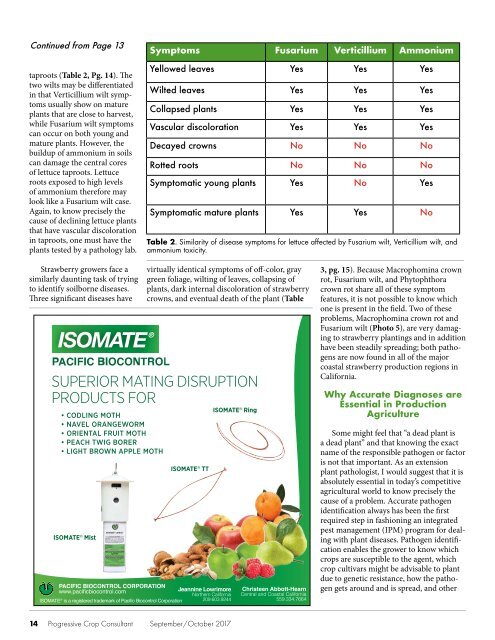September/October 2017
You also want an ePaper? Increase the reach of your titles
YUMPU automatically turns print PDFs into web optimized ePapers that Google loves.
Continued from Page 13<br />
taproots (Table 2, Pg. 14). The<br />
two wilts may be differentiated<br />
in that Verticillium wilt symptoms<br />
usually show on mature<br />
plants that are close to harvest,<br />
while Fusarium wilt symptoms<br />
can occur on both young and<br />
mature plants. However, the<br />
buildup of ammonium in soils<br />
can damage the central cores<br />
of lettuce taproots. Lettuce<br />
roots exposed to high levels<br />
of ammonium therefore may<br />
look like a Fusarium wilt case.<br />
Again, to know precisely the<br />
cause of declining lettuce plants<br />
that have vascular discoloration<br />
in taproots, one must have the<br />
plants tested by a pathology lab.<br />
Symptoms Fusarium Verticillium Ammonium<br />
Yellowed leaves Yes Yes Yes<br />
Wilted leaves Yes Yes Yes<br />
Collapsed plants Yes Yes Yes<br />
Vascular discoloration Yes Yes Yes<br />
Decayed crowns No No No<br />
Rotted roots No No No<br />
Symptomatic young plants Yes No Yes<br />
Symptomatic mature plants Yes Yes No<br />
Table 2. Similarity of disease symptoms for lettuce affected by Fusarium wilt, Verticillium wilt, and<br />
ammonium toxicity.<br />
Strawberry growers face a<br />
similarly daunting task of trying<br />
to identify soilborne diseases.<br />
Three significant diseases have<br />
ISOMATE<br />
virtually identical symptoms of off-color, gray<br />
green foliage, wilting of leaves, collapsing of<br />
plants, dark internal discoloration of strawberry<br />
crowns, and eventual death of the plant (Table<br />
SUPERIOR MATING DISRUPTION<br />
PRODUCTS FOR<br />
ISOMATE ® Mist<br />
PACIFIC BIOCONTROL CORPORATION<br />
www.pacificbiocontrol.com<br />
Jeannine Lowrimore<br />
Northern California<br />
ISOMATE ® is a registered trademark of Pacific Biocontrol Corporation 209.603.9244<br />
®<br />
• CODLING MOTH<br />
• NAVEL ORANGEWORM<br />
• ORIENTAL FRUIT MOTH<br />
• PEACH TWIG BORER<br />
• LIGHT BROWN APPLE MOTH<br />
ISOMATE ® TT<br />
ISOMATE ® Ring<br />
Christeen Abbott-Hearn<br />
Central and Coastal California<br />
559.334.7664<br />
3, pg. 15). Because Macrophomina crown<br />
rot, Fusarium wilt, and Phytophthora<br />
crown rot share all of these symptom<br />
features, it is not possible to know which<br />
one is present in the field. Two of these<br />
problems, Macrophomina crown rot and<br />
Fusarium wilt (Photo 5), are very damaging<br />
to strawberry plantings and in addition<br />
have been steadily spreading; both pathogens<br />
are now found in all of the major<br />
coastal strawberry production regions in<br />
California.<br />
Why Accurate Diagnoses are<br />
Essential in Production<br />
Agriculture<br />
Some might feel that “a dead plant is<br />
a dead plant” and that knowing the exact<br />
name of the responsible pathogen or factor<br />
is not that important. As an extension<br />
plant pathologist, I would suggest that it is<br />
absolutely essential in today’s competitive<br />
agricultural world to know precisely the<br />
cause of a problem. Accurate pathogen<br />
identification always has been the first<br />
required step in fashioning an integrated<br />
pest management (IPM) program for dealing<br />
with plant diseases. Pathogen identification<br />
enables the grower to know which<br />
crops are susceptible to the agent, which<br />
crop cultivars might be advisable to plant<br />
due to genetic resistance, how the pathogen<br />
gets around and is spread, and other<br />
14 Progressive Crop Consultant <strong>September</strong>/<strong>October</strong> <strong>2017</strong>


















